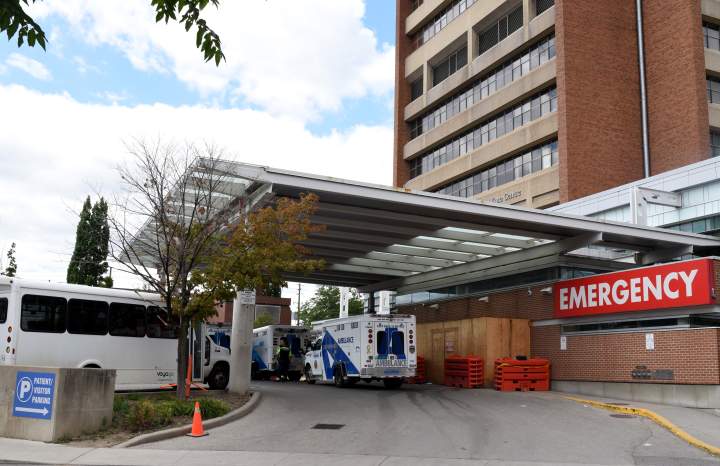
By
Teresa Wright
Global News
Published September 27, 2022
9 min read

Emergency physician Dr. Raghu Venugopal doesn’t mince words when describing the realities his patients have been facing in the emergency departments in which he works in Toronto.
“It’s really a dire situation,” he said after a recent shift in the ER.
Wait times are “exceedingly long” for even the most urgent care, with some patients waiting 100 to 125 hours for treatment, he says.
“My trauma victim may stay on a stretcher for four days straight. My elderly senior citizens will easily be on a stretcher for three days, having their entire admission on a stretcher in the ER.”
Venugopal is one of many ER doctors and other front-line health-care workers who have been raising the alarm about a “national crisis” in Canada’s health-care system.
For months, these doctors and nurses have used any platform available to them urgently call attention to the situation in ERs across Canada that they say has become unsustainable due to an unprecedented shortage of staff. It is a phenomenon happening in tandem with a recent surge in demand for health services. COVID-19 is partially to blame for this spike, but so too is a national shortage of family doctors that has resulted in many patients without preventative care becoming sicker and in need of more intensive health interventions.
Canadians can be forgiven if they are confused about whether the situation is indeed a crisis, given the lack of urgent response from governments and mixed messaging from some politicians, Venugopal says.
For example, last month, after more than 20 emergency departments across Ontario had to temporarily close and divert patients due to insufficient staff, Health Minister Sylvia Jones downplayed the situation, saying that to call it a crisis is “completely inappropriate.”
“What we’re observing is a real disconnect on the facts,” Venugopal said.
The situation in emergency rooms across this country is “demoralizing,” he says, and many nurses and doctors are speaking out because they see a “a gap in leadership” that is not doing enough to remedy the situation, he said.
“They really lack credibility and they really seem out of touch with the experience of the day-to-day patients and day-to-day nurses and doctors.”
Despite Jones’ dismissal of the term, the Canadian Medical Association (CMA) has repeatedly called the hemorrhaging of hospital and health-care staff a “national crisis.” And while provincial politicians have promised action, all 13 of Canada’s premiers also argue more federal funding is what’s needed.
They presented a unified plea to the federal government to increase the share of health care costs through the Canada Health Transfer from 22 to 35 per cent during a first-ministers summit in July.
They say provinces are paying the lion’s share of health costs, despite health-care funding being a shared responsibility between provincial and federal governments, and an influx of cash is needed from Ottawa to “support the reallocation of services,” B.C. Premier John Horgan said at the summit in July.
But Prime Minister Justin Trudeau has repeatedly responded to these demands saying he wants to see “tangible results” from the provinces with the $45.2 billion they will already receive this year for health care.
In the past, “huge investments” by provincial and federal governments haven’t always delivered necessary improvements, Trudeau told reporters in July.
But he has remained vague about exactly what results Ottawa wants to see achieved, saying only broadly that Canadians should have better access to family doctors, mental health treatment and that medical backlogs should be reduced.
Federal Health Minister Jean-Yves Duclos declined multiple requests for an interview with Global News, but in a brief response to two questions outside the House of Commons last week, he said he wants to respect the jurisdiction provinces and territories have over health care delivery in Canada, while also acknowledging that Ottawa shares the “responsibility of serving the same Canadians with the same (taxpayers) dollars.”
“I’m there to support them,” he said.
“I know their job is difficult and that the health-care crisis is there because it is a health-care workers crisis – which has been and keeps being exacerbated by the COVID-19 crisis – and for which we need to do dramatic investments.”
But when asked why Ottawa has not yet delivered on its election promise last year of $3.2 billion for provinces and territories to hire 7,500 new family doctors and nurses – money that was supposed to begin rolling out this year – Duclos walked away without responding.
B.C. Health Minister Adrian Dix says provincial governments cannot be left to bear the financial brunt of what has become a more costly system to manage in recent years. These costs are only projected to rise with Canada’s aging population, he said.
“The federal government has said they expect higher standards in various areas, including long-term care and others, so they’ve got to come up to the table. And unfortunately, in the last little while, they simply haven’t done it.”
Instead of increasing transfers, Ottawa has instead preferred to provide targeted, one-time payments in specific areas, Dix says, such as increasing surgeries or reducing backlogs.
He argues these are “short-term” fixes that don’t allow for longer-term planning, especially in staffing.
“If you’re going to build a surgical team in a hospital, one-year funding doesn’t cut it, two-year funding doesn’t cut it,” he said. “It’s not that we say no to it when it’s offered. Of course not … But they’ve got to step up.”
So, who’s job is it to fix the problems plaguing Canada’s overburdened health system?
It’s both the federal and provincial government’s responsibility, says B.C.-based health policy analyst Andrew Longhurst.
While provinces and territories are tasked with overseeing health-care delivery – responsibilities that are often split with municipalities and regional health authorities – Ottawa also has a vital role to play in “setting and administering national principles for the system under the Canada Health Act,” in addition to providing financial support, according to Health Canada’s website.
But even as the federal government came to the provinces’ aid over the last two years with billions of additional dollars toward the public health response to COVID-19, health care access has declined and premiers have continued to ask for more money, Longhurst said.
“I think in all of this and the federal government is very right to be concerned about continuing to write cheques to the provinces without certainty and accountability of how those dollars are being spent.”
But, he adds, Ottawa should also bear some responsibility in showing leadership and ensuring that accountability is built into funding models, he said.
“This back and forth of playing blame-shifting where the premiers are telling the feds: ‘We just need more money.’ And funding is a big part of that, no question, but a lot of the policy changes aren’t about money,” Longhurst said.
“They’re about how we organize the delivery of health-care services, how we pay physicians … how do we reform?”
A lack of timely changes in the health system to respond to shifting health-care needs across the country “absolutely falls to the provinces who have not been focusing on the issue,” he added.
But some political leaders are indeed ready to embrace the changes needed to help stabilize health-care services, including the mayor of Perth, Ont., John Fenik.
His town’s hospital emergency department was forced to close for almost a month in July due to critical staffing shortages. This had a significant impact not only on his residents, but also those of several surrounding townships that rely on Perth’s ER, he said.
That’s why he says he’s willing to do whatever it takes to come up with urgent and implementable solutions that will keep health services open and available to patients.
But this can’t happen until all government leaders take responsibility and stop pointing fingers over whose job it is to fix the problems, Fenik said.
“It’s time for leaders in the provincial and federal positions, (for) Prime Minister Trudeau to not say, ‘It’s your responsibility, Doug Ford,’ or Doug saying, ‘We need more funds.’ It is our issue. We have to collectively sit around the table and solve it,” he said.
“This back and forth does nothing for one of my citizens that needs to get to the ER when the doors are shut. So, the buck stops here with me.”
Even as they call for more federal funds, most provinces have been trying to address the challenges in their health systems in their own individual ways.
For example, Saskatchewan recently announced new investments to bolster health staffing, including a new agency dedicated to recruiting and retaining nurses and doctors, as well as money to increase the number of family medicine residency training seats and nurse training seats.
Manitoba’s budget this year had money for a special task force to address surgical and diagnostic backlogs and is investing in new education and recruitment programs for nurses.
Last month, Ontario announced it would increase the number of publicly-covered surgeries performed at private clinics, as well as waive exam and registration fees for internationally trained nurses and will send patients waiting for a long-term care bed to a home not of their choosing.
Prince Edward Island has been trying to adopt more team-based approaches to primary care called “medical homes and neighbourhoods” to reduce a significant number of patients without family doctors.
And Alberta has been investing significant funds and energy into reducing surgical backlogs.
Ronan Segrave, Alberta’s surgical recovery lead, says a task force dedicated to this work has made some welcome progress in streamlining referrals and intake of patients – embracing new technologies to do so – and ensuring operating rooms are operating as effectively as possible.
Major changes in any health system can be “disruptive,” he says, but he believes patients, health-care workers and government alike know that even disruptive change is necessary to make improvements, Segrave said.
“We’re starting to embed changes that are more transformational in nature, moving forward to a world where people waiting outside of recommended wait time simply doesn’t happen in the future,” he said.
“We’re changing processes, changing the pathways, changing how we deliver care, using the right technology and tools … We want solutions and changes that will be sustainable, not just in the short term, as important that is, but in the medium to longer term.”
For those on the front lines of Canada’s health care “crisis,” this kind of change can’t come soon enough.
Nurses in particular have been bearing the brunt of patient frustrations over long wait times and lack of timely access to care.
And it’s been taking its toll on the dwindling numbers of nurses who have not decided to retire early or leave the profession entirely, as many across Canada have been doing in recent months, says Jane Casey, a registered nurse and director of emergency at Humber River Hospital in Ontario.
“There have been times where the stress of the moment gets to people and they do raise their voice and are quite concerned,” Casey said.
“So I would say, pack your patience. We’re doing the very best we can.”
With files from Global News’ Jamie Mauracher







Comments